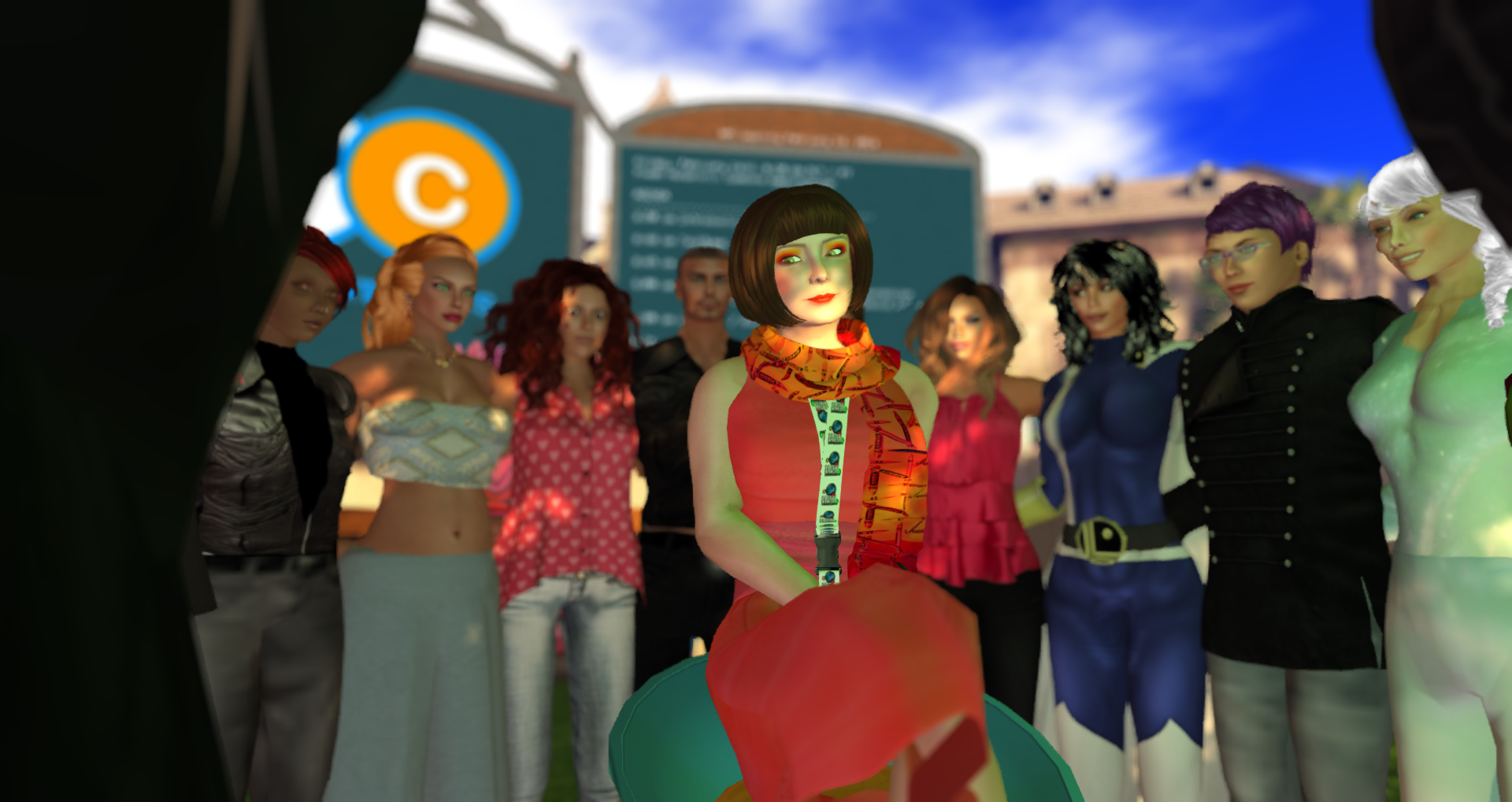Hi, I’m BJ Wishinsky, Communities Program Manager for the Anita Borg Institute for Women and Technology (http://anitaborg.org/). At Glitter and Penguin’s requests, I’m cross-posting here my live-blog on this event from the NetSquared Conference blog.
My avatar, Biji Mornington, has been attending Nonprofits in SecondLife (NPSL) meetings at the Nonprofit Commons (NPC; http://nonprofitcommons.org/) on Friday mornings. So when Megan Keane (Penguin Asana in SL) asked me to live-blog this mixed-reality event, I said yes. A lot of the buzz at NPSL meetings of late has been about the launch of NPC’s second island, Aloft, and plans for this morning’s mixed reality launch event. Our panelists are physically here at the Netsquared Conference and virtually inworld at Aloft. Here in San Jose, CA we can see avatars gathering at Aloft, and at Aloft the avatars also see our panelists by video. Evonne Heyning (In Zenzo) introduced our panel:
* Sandy Andrews (Ozma Malibu) of Floaters
* Dick Dillon (Coughran Mayo) of Preferred Family Healthcare
* Rik (Rik Riel) of Global Kids
* Jessica (Kali Idziak) of Community Voicemail
* Rebecca Wise (Jani Myriam) of Transgender Resource Center
Susan Tenby (Glitteractica Cookie) then kicked us off by introducing the Nonprofit Commons, a TechSoup project that provides to real world nonprofits virtual office space and support in SecondLife. Susan is the driving force, but other TechSoup staff and many volunteers make this a tremendous resource for nonprofits exploring how SecondLife can help them build community and meet their organizations’ goals. Currently about 70 nonprofits have free inworld office space at the two NPC islands, on donated land. There are two SL groups that avatars can join: Nonprofit Commons (NPC residents only), and the TechSoup group of those who, like me, are interested in nonprofit use of SL but not ready to commit to office hours. Volunteers are always needed and new group members are always welcome. Volunteers come from dozens of countries. Those of us who attend NPSL meetings are happy to be here today and finally meet our colleagues in person. One great thing about SecondLife is you don’t have to be anywhere specifically, physically, to do anything. But it’s nice to meet face to face when we get the chance.
Sandy tells us about Floaters, a program that provides access to those who otherwise wouldn’t have access. Her group has been able to connect, through NPSL, with other groups who have similar goals. With Bridges for Women, Kiva, and others they are planning a large scale project for people who are displaced, homeless, survivors of domestic violence, or otherwise in transition: http://www.aplacefordreams.com/. They’ll provide services and mentors for the displaced and homeless, who can log in to SecondLife from places like McDonalds. They are looking for a programmer to help with a widget that would help people find shelter, food, training on life skills and computer skills. They offer free voicemail also. Services will be available from both the website and SecondLife. They offer training that will help people design and build a business in SecondLife, and hope they will in turn become mentors themselves.
Dick gets a big laugh by saying he was drawn to SL by the ease of use of the technology. Those who have organized this panel have had to work through several technical issues (apparently voice from the panel just now started coming through in Aloft). His agency is a nonprofit mental health service provider with emphasis primarily on drug abuse programs. They’re big, with 35 offices and 500 employees. They’ve been aggressively exploring SecondLife as a platform for the last year. In the mental health field the ability to reach out to people in hard-to-reach places is critical. If it would take too much time, effort or energy to get to an office, many people won’t go. So any technology from telephone and chat rooms to virtual worlds can be a big help in bridging that gap. A virtual world provides a sense of place, once people have learned the basics of getting around, and the real-time interactions help blur the distinction between real life and the virtual world in getting clients involved. And there are trade-offs. A client asked about lack of body language in SL. Coughran, his avatar, showed the client 40 different body positions his avatar could assume and also noted that when communicating face-to-face we don’t have the benefit of emoticons.
Our next speaker is Rebecca from the Transgender Resource Center. She talks about the behavioral health implications of SecondLife and says SL has unique qualities that make it an ideal environment for self-discovery. It’s safe and anonymous; you can delete your avatar at any time. It’s deeply immersive, so you can really explore your avatar’s identity by customizing it in ways you might not risk in real life. SL as a diverse and tolerant community. Yee and Bailenson’s 2007 report “The Proteus Effect” showed that as individuals explore their avatar’s self-representation, this in turn has an impact on their real-life self-identity. She told us her personal story and how important SL was in providing a safe space to explore her own gender identity. In SL, with a distinctly female avatar, no one questioned her identity and she could explore this safely. She was also able to make some connections in SL that pointed her to resources in real life that helped her with her own transition. Based on that experience she founded the Transgender Resource Center in SecondLife which provides a unique resource for community, information and peer support. Inworld they provide book excerpts, movie trailers, links to web sites and forums, bi-monthly support groups, and more. In the Nonprofit Commons TRC has found a supportive community of peers and mentors frm other nonprofit organizations, as well as free virtual office space, tools and training. TRC has over 800 members now.
Jessica’s organization, Community Voicemail, provides 24 hour voicemail service to people in crisis and transition. These phone numbers can be used for job searches, to connect with family, medical care and other resources, for people who are homeless, between jobs, etc. Community Voicemail has a multi-year grant from Cisco (our conference hosts) and heard about SecondLife from Cisco and then connected with TechSoup/NPC. They partner with nonprofits and agencies in different areas and SecondLife gives them a rich way to make these connections and spread the word about the services they provide. People in SecondLife are very community-minded and help spread the word, give advice, etc.. They don’t have a dedicated person on SecondLife but she spends part of her time there.
Rik Panganiban is a SecondLife producer for Global Kids. Global Kids empower the kids by teaching them technology and leadership skills. His topic “Turn Off the Damn PC and Go Outside” got a laugh from the (real) room. This was a line from a post on Boingboing.net that initially inspired his perspective on virtual worlds. They use the teen grid in SL as a space where real learning happens. Earlier this year they streamed Kofi Annan talking about human rights into SL, where the kids had their own conversations about human rights and what that means to them. They use virtual worlds to foster leadership, self-confidence and collaboration skills, and engage them in working for real change in the real world. Their International Justice Center in SL will provide access to war crimes trials and opportunities for dialogue and learning. Global Kids is looking at the crisis in Darfur, giving them information and access to activists, and they are brainstorming with kids in other countries about solutions. They’re currently working on an application that would provide access on mobile phones for those who do not have access to computers for virtual worlds.
Inworld, the Aloft Nonprofit Commons festivities continue throughout the day with games, music, and tours. Here at the NetSquared Conference, I’m looking forward to sitting at a SecondLife table at lunch.
Written by: BijiMornington

